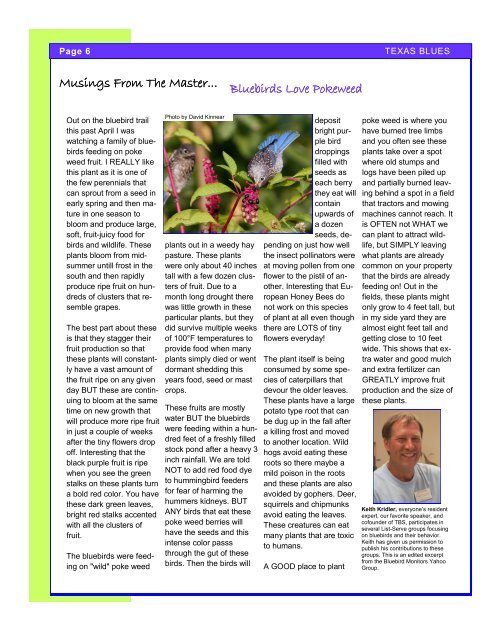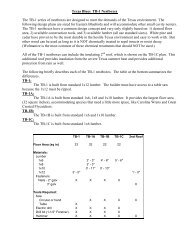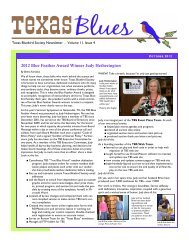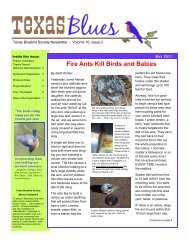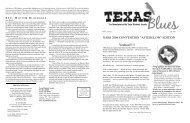New Heat Study Results Provide Cool Solutions - Texas Bluebird ...
New Heat Study Results Provide Cool Solutions - Texas Bluebird ...
New Heat Study Results Provide Cool Solutions - Texas Bluebird ...
Create successful ePaper yourself
Turn your PDF publications into a flip-book with our unique Google optimized e-Paper software.
Page 6<br />
TEXAS BLUES<br />
Musings From The Master...<br />
<strong>Bluebird</strong>s Love Pokeweed<br />
Out on the bluebird trail<br />
this past April I was<br />
watching a family of bluebirds<br />
feeding on poke<br />
weed fruit. I REALLY like<br />
this plant as it is one of<br />
the few perennials that<br />
can sprout from a seed in<br />
early spring and then mature<br />
in one season to<br />
bloom and produce large,<br />
soft, fruit-juicy food for<br />
birds and wildlife. These<br />
plants bloom from midsummer<br />
untill frost in the<br />
south and then rapidly<br />
produce ripe fruit on hundreds<br />
of clusters that resemble<br />
grapes.<br />
The best part about these<br />
is that they stagger their<br />
fruit production so that<br />
these plants will constantly<br />
have a vast amount of<br />
the fruit ripe on any given<br />
day BUT these are continuing<br />
to bloom at the same<br />
time on new growth that<br />
will produce more ripe fruit<br />
in just a couple of weeks<br />
after the tiny flowers drop<br />
off. Interesting that the<br />
black purple fruit is ripe<br />
when you see the green<br />
stalks on these plants turn<br />
a bold red color. You have<br />
these dark green leaves,<br />
bright red stalks accented<br />
with all the clusters of<br />
fruit.<br />
The bluebirds were feeding<br />
on "wild" poke weed<br />
Photo by David Kinnear<br />
plants out in a weedy hay<br />
pasture. These plants<br />
were only about 40 inches<br />
tall with a few dozen clusters<br />
of fruit. Due to a<br />
month long drought there<br />
was little growth in these<br />
particular plants, but they<br />
did survive multiple weeks<br />
of 100°F temperatures to<br />
provide food when many<br />
plants simply died or went<br />
dormant shedding this<br />
years food, seed or mast<br />
crops.<br />
These fruits are mostly<br />
water BUT the bluebirds<br />
were feeding within a hundred<br />
feet of a freshly filled<br />
stock pond after a heavy 3<br />
inch rainfall. We are told<br />
NOT to add red food dye<br />
to hummingbird feeders<br />
for fear of harming the<br />
hummers kidneys. BUT<br />
ANY birds that eat these<br />
poke weed berries will<br />
have the seeds and this<br />
intense color passs<br />
through the gut of these<br />
birds. Then the birds will<br />
deposit<br />
bright purple<br />
bird<br />
droppings<br />
filled with<br />
seeds as<br />
each berry<br />
they eat will<br />
contain<br />
upwards of<br />
a dozen<br />
seeds, depending<br />
on just how well<br />
the insect pollinators were<br />
at moving pollen from one<br />
flower to the pistil of another.<br />
Interesting that European<br />
Honey Bees do<br />
not work on this species<br />
of plant at all even though<br />
there are LOTS of tiny<br />
flowers everyday!<br />
The plant itself is being<br />
consumed by some species<br />
of caterpillars that<br />
devour the older leaves.<br />
These plants have a large<br />
potato type root that can<br />
be dug up in the fall after<br />
a killing frost and moved<br />
to another location. Wild<br />
hogs avoid eating these<br />
roots so there maybe a<br />
mild poison in the roots<br />
and these plants are also<br />
avoided by gophers. Deer,<br />
squirrels and chipmunks<br />
avoid eating the leaves.<br />
These creatures can eat<br />
many plants that are toxic<br />
to humans.<br />
A GOOD place to plant<br />
poke weed is where you<br />
have burned tree limbs<br />
and you often see these<br />
plants take over a spot<br />
where old stumps and<br />
logs have been piled up<br />
and partially burned leaving<br />
behind a spot in a field<br />
that tractors and mowing<br />
machines cannot reach. It<br />
is OFTEN not WHAT we<br />
can plant to attract wildlife,<br />
but SIMPLY leaving<br />
what plants are already<br />
common on your property<br />
that the birds are already<br />
feeding on! Out in the<br />
fields, these plants might<br />
only grow to 4 feet tall, but<br />
in my side yard they are<br />
almost eight feet tall and<br />
getting close to 10 feet<br />
wide. This shows that extra<br />
water and good mulch<br />
and extra fertilizer can<br />
GREATLY improve fruit<br />
production and the size of<br />
these plants.<br />
Keith Kridler, everyone’s resident<br />
expert, our favorite speaker, and<br />
cofounder of TBS, participates in<br />
several List-Serve groups focusing<br />
on bluebirds and their behavior.<br />
Keith has given us permission to<br />
publish his contributions to these<br />
groups. This is an edited excerpt<br />
from the <strong>Bluebird</strong> Monitors Yahoo<br />
Group.


